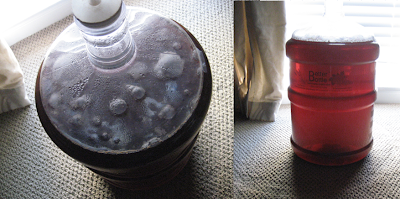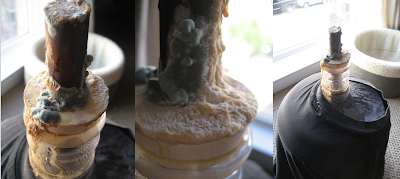So about 2 weeks ago I decided that it would be a good idea to add an Oak Dowel to my 2 month old Flanders Red. It already had a nice pellicle as you can see below.

For the Oak Dowel I boiled it three times and then stuck through a sanitized rubber stopper that was drilled to fit. So after 2 weeks I checked on it and this is what I found.

I have no clue what that is and if it is ok or not. The other strange part is that the pellicle is gone. I decided to clean the dowel and stopper in place with sanitizer. Should I scrap the dowel method or boil it and try it again. Also I am just going to hope nothing happened to the beer but it doesn't appear that there is any mold in the beer. Any feedback or reassurance would be great.
I have more details on the brew here:http://jeffreycrane.blogspot.com/2010/06/sour-beer-2010-flanders-red.html

For the Oak Dowel I boiled it three times and then stuck through a sanitized rubber stopper that was drilled to fit. So after 2 weeks I checked on it and this is what I found.

I have no clue what that is and if it is ok or not. The other strange part is that the pellicle is gone. I decided to clean the dowel and stopper in place with sanitizer. Should I scrap the dowel method or boil it and try it again. Also I am just going to hope nothing happened to the beer but it doesn't appear that there is any mold in the beer. Any feedback or reassurance would be great.
I have more details on the brew here:http://jeffreycrane.blogspot.com/2010/06/sour-beer-2010-flanders-red.html


